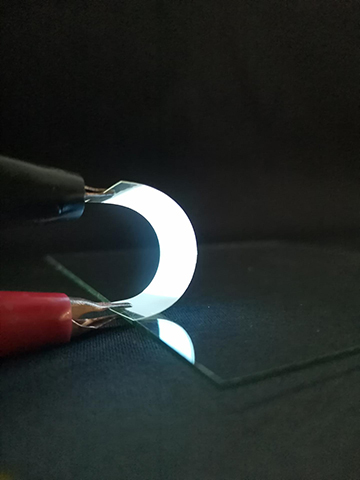
A research team at Nanjing Tech University, China, has developed a method for creating transparent, flexible light-emitting devices, using films made from fish-scale gelatin as a substrate. The team believes that the films could offer an environmentally friendly alternative to plastics in the creation of flexible and wearable optoelectronic devices. [Image: Adapted from ACS Nano, doi: 10.1021/acsnano.9b09880 (2020)]
As the environmental toll of plastic microparticles and nanoparticles has grown ever more apparent, the possible impact of plastic films in optoelectronic devices—particularly in disposable wearable technologies under development—has started to raise concerns. A research team at Nanjing Tech University, China, now offers one possible answer: Make the films out of fish scales (ACS Nano, doi: 10.1021/acsnano.9b09880).
The promise of “electronic skin”
The Nanjing Tech team zeroed in on the transparent plastic films used in a particular type of optoelectronic gadget: flexible alternating-current electroluminescent (ACEL) devices.
ACELs, which involve integrating and wiring up luminescent materials atop thin, bendable transparent substrates, have advanced to the point where they sport uniform luminescence, good power handling and efficiency, and low heat generation. That makes them particularly attractive for wearable technology. Developers have even envisioned a new generation of single-use, “electronic skin”-type applications such as glowing temporary tatoos, or single-use filmy stopwatches that runners could slap onto their skin before a race and remove and toss afterward.
Sustainability double-whammy
Such single-use display technologies create their own concerns, however. That’s because a main component of these envisioned wearable displays is thin, flexible substrates of plastics such as polyethylene terephthalate (PET), polyethylene naphthalate and polycarbonate. In sustainability terms, these materials pack a double-whammy. On one hand, they’re created from nonrenewable fossil-fuel feedstocks, and their production contributes non-trivially to climate change.
On the other, the discarded plastics could add to the already alarming impact of plastic waste in the environment. As noted in a recent review in the Journal of Geophysical Research, the accumulation of microplastics and nanoplastics into gigantic marine “garbage patches” has captured media attention, and highlighted the environmental hazards of discarded plastics in places far from the point at which they’re thrown away.
Overlooked raw material
In light of this, researchers have scouted around for alternative substrate materials for optoelectronic-skin applications that might carry less of an environmental punch. Candidates have included cellulose from trees, the harvesting of which raises its own sustainability questions; and silk proteins from silkworms, which could be too pricey to use in mass production for disposable optoelectronics.
The Nanjing Tech team, led by Hai-Dong Yu, Juqing Liu and Wei Huang, focused on a different material: gelatin from fish scales. The material, the researchers argue, sports some potentially good optoelectronic qualities. As important, a huge amount of the stuff is available as raw material; inedible waste fish scales account, according to the authors, for “about 3% of annual production of the 70.5 million metric tons of fish.” And the scale gelatin is biodegradable, which suggests that, once discarded, it would eventually fade back into the environmental background.
From fish scales to luminescent devices
To put these ideas to the test, the Nanjing Tech team began by washing and chemically pre-treating fish scales to create a precursor solution, which the researchers cast in a petri dish into films made of fish-scale gelatin. Tests revealed that the clear film sported up to 91.1% transmittance across the visible spectrum—actually a touch better than PET films, which have a transmittance of 90.4%. The films also showed good flexibility and could even be reversibly folded. And the researchers found that the film was easily recyclable (dissolving within seconds in 60 °C water) and biodegradable (breaking down completely in soil within 24 days).
The team next used the fish-scale gelatin film as a substrate for several luminescent devices. They coated the gelatin film with a layer of silver nanowires to act as a lower electrode, and then spin-coated on an emission layer impregnated with luminescent particles, and topped the stack off with another nanowire layer as an upper electrode. The team found that the stack glowed brightly under applied alternating current—with “no significant drop in emission intensity” even after a thousand cycles of bending and relaxing.
The Nanjing Tech researchers conclude that their method “offers environmentally friendly optoelectronic products without harmful byproducts and electronic wastes.” And they believe their fish-scale-sourced films could have a future not only in wearable tech but in flexible displays.
